So the train ride from Cusco ended in Puno, an ugly little town on the shores of Lago Titicaca that dumps most of its refuse untreated into the lake.
Even though the Lonely Planet said the tours of the Titicaca Islands - the floating islands of the Uros, Amantani & Taquile - were mostly disappointing and downright exploitative, I decided to sign up willy-nilly with some random operator for a 2-day tour with one night to be spent on Amantani with a local family.
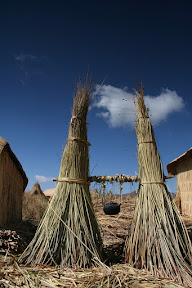
The Uros' floating reed islands were a bit of Disneyland on water. Basically, the traditional way of life was to cut free reed growing in the lake (including the roots) and tie several large pieces together to get a floating island with the actual float being up to 3m thick.
Thing is, the whole thing looked and felt highly artificial, from the presentation of how the islands were built down to the people dressed up in traditional clothes and only being there for tourists.
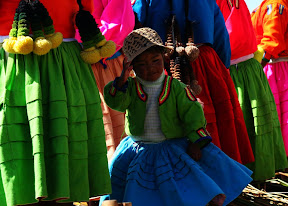
Nevertheless, as we made our rounds and I staunchly refused to buy anything from the small stalls set up everywhere, you could get some small insights into what life on the islands was really like...
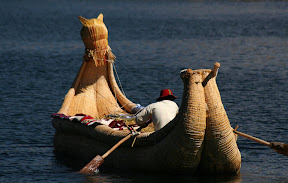
While most of the people on our tour went for a ride in a reed boat, I elected to stay behind and was promptly joined by one of the locals; we got to talking and as well as finding out that he was taking french lessons and hoping to get a tourism degree and a job on the mainland - as were most of the young people - he also told me that child mortality ws incredibly high on the islands. What with living mere inches above the water, temperatures dropping down to sub-zero at night large numbers of children up to the age of 5 years were dying of pneumonia or drowning by accident, as had happened to this young man's first child.
Our guide also commented that the only thing keeping people and their lifestyle alive were tourists and the money they left, the lake being so polluted close to Puno and overfishing having reduced the catch in the rest of the lake, that the Uro's traditional occupation of fishing was mostly reduced to a pastime.
While I'm not saying that some of the tours of the Uros islands won't be exploitative, in this case it does depend on what you make of the tour: a rather disappointing reed Disneyland experience, or a peek behind the scenes of how people live, whose only resource is tourism and who put up with sometimes appalling conditions to keep up a pretty facade.

We kept going on our little boat through the reed-edged waterways toward the open lake after that brief interlude. A biting headwind made me gear up in fleece, windjacket, gloves and hat despite the intense sun. When on the lake, you are at close to 4000m altitude!

Hidden in the reed - called totora locally - a corrugated iron shed stood... to no apparent purpose.
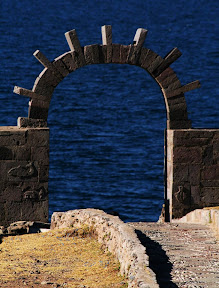
Arriving on Amantani, the first, and lesser-visited island compared to Taquile, we were assigned to our guest families and taken off on a 20 minute climb up the gentle slopes to their respective houses. The deep blue of the water, the sparse and dry vegetation and small farming plots made for great views.
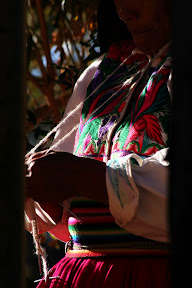
Pabla, our host, was of exemplary patience, as the french girls and I who were staying in her house kept her waiting time and time again, establishing a bit of a reputation for getting to every meeting point last.
She and her husband Demetrio were very welcoming, cooked for us, provided us with a bit of an insight into their life on the island and showed us every conceivable kindness! Demetrio takes care of the local library of one of the nine communities on the island. He told us that he had trouble providing enough books for children who wanted to read and learn about different things and later proceeded to show us the library: a shack with 4 rows of benches and tables, set out like school with one meager half-full cardboard box in the corner, in which all the books were kept. I think he had one english-language one to go around.

Heading down to the pebble beach so we could pretend to have had a dip in the lake - bloody freezing water! - we happened upon a group of kids tending their flock of sheep. The little black one was almost adopted as part of their outreach program :-)

Our next date was with the setting sun, best seen from the top of the highest hill of the island, that also housed a Pachatata shrine (the Pachamama - mother earth - antipode).

Looking across the island from the top of the hill was amazing.
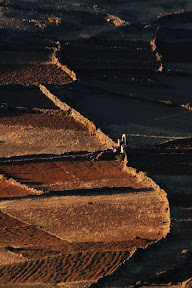
Sunlight slanting across the stone enclosures used to divide the fields made for a great play of light and shadow.

Looking due west from the hilltop into the setting sun.
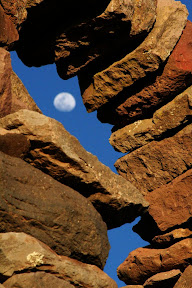
The moon was out in force as well.
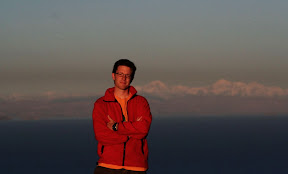
Unsure of which position to adopt for that picture, and because I saw strictly nothing looking into the sun, I opted for cool.

I think I may have done my retina some permanent damage, squinting into the sunlight in order to get that shot. The two german girls also on our tour look a bit otherworldly...

Ah, sweet jumping pics...

... in front of the setting sun ...

...while some can't quite manage to look good doing it ....

... but things turned out alright in the end!
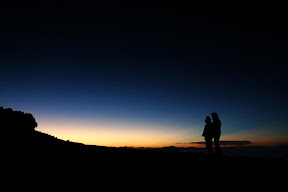
I don't think I've ever seen skies as dark blue as the ones over Lake Titicaca, with the possible exception of Australian skies and ones seen from cruising airliners at 40,000 feet.

The moon screwed with my avowed aim of seeing the Milky Way laid out before me in all its glory. When it's full moon, stars are overwhelmed by its awesome shine.

Some pics turned out alright. I'd appreciate it if anyone could tell me what constellations I'm looking at here.

After a restful night on Amantani and an early start, we headed over to Taquile - the more touristy of the two islands. When we got there, a band started playing and I was assailed by nightmarish visions of another Disneyland experience.
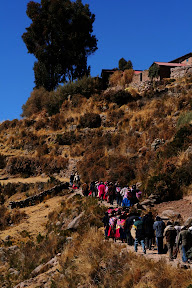
In fact, it was a wedding party arriving on Taquile from another island to start festivities for an inter-island wedding, something quite inconceivable a few decades ago.

While we tourists huffed and puffed our way up the islands paths, they played their instruments - horns, trumpets, tubas etc - as they went without being out of breath. Okay, so a little Chicha - locally brewed maize alcohol - seems to have helped!

I think this might be the Cordillera Real off in the distance on the Bolivian side of the lake. Makes me want to climb them!

Dry yellow earth, a few trees - including some Eucalyptus trees - and the deep blue of the water. Quite a sight!

Everyone was dressed up - either for the wedding or for the tourists - and kids were flying kites while distinctly alcoholic-smelling adults wandered about. Alcoholism is a hug problem on the island, as our guide told us.
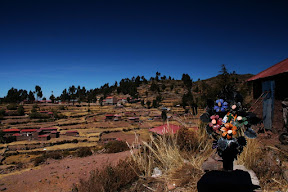
Looking across the island and its fields. Nowadays, tourism is the only money-earner here and is the only prop that keeps traditional costumes and lifestyles kicking. Strange customs such as having a child first and spending a few years together as a couple as a prelude to getting married still prevail on Taquile. The rule is: if you're unable/unwilling to conceive, you split up or leave the island; same if you're determined not to marry.

Colourfully decked-out with wild flowers, a portal welcomes the bridal party.

The setting is very picturesque, the buildings for the most part fit in well with kitschy cliches of traditional island life...

...it's just that, from looking at some of the idol-like statues. I wasn't ever quite sure whether catholic faith really had taken hold here,.

Our tour group waiting to be taken to lunch - I couldn't resist that one.

Little girls coming up to you with a can of fingernail-paint and a brush aren't always guarantors of a job well done, as the french girls found out when they turned up later with only one hand done ... and red paint smudged over part of their nails and part of their fingers.
All in all, a great experience, if only for the fact that you could get a behind-the-scenes look at the scenic surface if only you could be bothered to talk to people, listen to the admittedly excruciating cadence of the guide's english and open your eyes.
Keine Kommentare:
Kommentar veröffentlichen